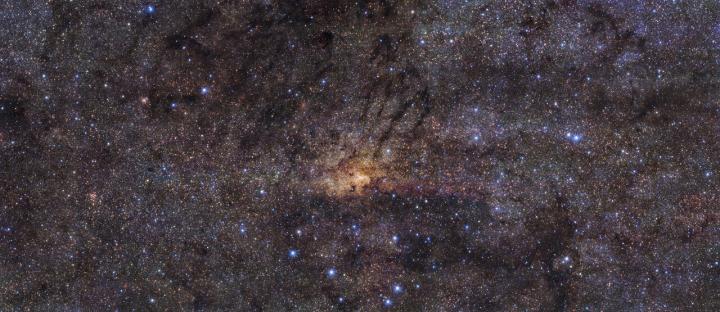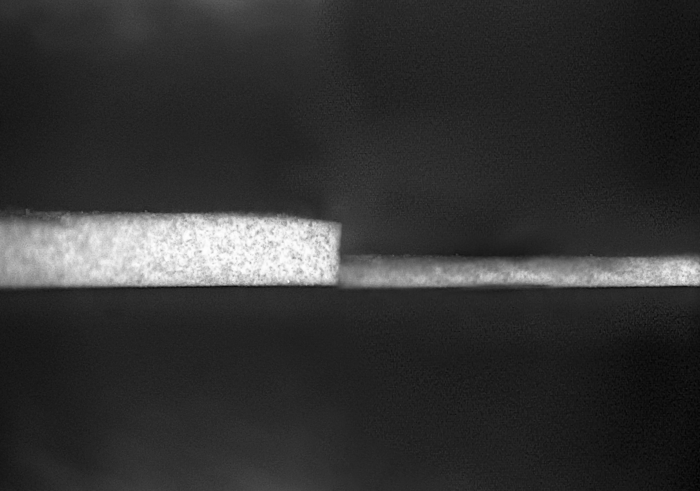
Credit: ESO/Nogueras-Lara et al.
ESO’s Very Large Telescope (VLT) has observed the central part of the Milky Way with spectacular resolution and uncovered new details about the history of star birth in our galaxy. Thanks to the new observations, astronomers have found evidence for a dramatic event in the life of the Milky Way: a burst of star formation so intense that it resulted in over a hundred thousand supernova explosions.
“Our unprecedented survey of a large part of the Galactic centre has given us detailed insights into the formation process of stars in this region of the Milky Way,” says Rainer Schödel from the Institute of Astrophysics of Andalusia in Granada, Spain, who led the observations. “Contrary to what had been accepted up to now, we found that the formation of stars has not been continuous,” adds Francisco Nogueras-Lara, who led two new studies of the Milky Way central region while at the same institute in Granada.
In the study, published today in Nature Astronomy, the team found that about 80% of the stars in the Milky Way central region formed in the earliest years of our galaxy, between eight and 13.5 billion years ago. This initial period of star formation was followed by about six billion years during which very few stars were born. This was brought to an end by an intense burst of star formation around one billion years ago when, over a period of less than 100 million years, stars with a combined mass possibly as high as a few tens of million Suns formed in this central region.
“The conditions in the studied region during this burst of activity must have resembled those in ‘starburst’ galaxies, which form stars at rates of more than 100 solar masses per year,” says Nogueras-Lara, who is now based at the Max Planck Institute for Astronomy in Heidelberg, Germany. At present, the whole Milky Way is forming stars at a rate of about one or two solar masses per year.
“This burst of activity, which must have resulted in the explosion of more than a hundred thousand supernovae, was probably one of the most energetic events in the whole history of the Milky Way,” he adds. During a starburst, many massive stars are created; since they have shorter lifespans than lower-mass stars, they reach the end of their lives much faster, dying in violent supernova explosions.
This research was possible thanks to observations of the Galactic central region done with ESO’s HAWK-I instrument on the VLT in the Chilean Atacama Desert. This infrared-sensitive camera peered through the dust to give us a remarkably detailed image of the Milky Way’s central region, published in October in Astronomy & Astrophysics by Nogueras-Lara and a team of astronomers from Spain, the US, Japan and Germany. The stunning image shows the galaxy’s densest region of stars, gas and dust, which also hosts a supermassive black hole, with an angular resolution of 0.2 arcseconds. This means the level of detail picked up by HAWK-I is roughly equivalent to seeing a football (soccer ball) in Zurich from Munich, where ESO’s headquarters are located.
This image is the first release of the GALACTICNUCLEUS survey. This programme relied on the large field of view and high angular resolution of HAWK-I on ESO’s VLT to produce a beautifully sharp image of the central region of our galaxy. The survey studied over three million stars, covering an area corresponding to more than 60 000 square light-years at the distance of the Galactic centre (one light-year is about 9.5 trillion kilometres).
###
More information
This research was presented in the paper “GALACTICNUCLEUS: A high angular resolution JHKs imaging survey of the Galactic Centre: II. First data release of the catalogue and the most detailed CMDs of the GC” published in Astronomy & Astrophysics and in “Early formation and recent starburst activity in the nuclear disc of the Milky Way” to appear in Nature Astronomy (doi: 10.1038/s41550-019-0967-9).
The team of the Astronomy & Astrophysics paper is composed of F. Nogueras-Lara (Instituto de Astrofísica de Andalucía, Granada, Spain [IAA-CSIC]), R. Schödel (IAA-CSIC), A. T. Gallego-Calvente (IAA-CSIC), H. Dong (IAA-CSIC), E. Gallego-Cano (IAA and Centro Astronómico Hispano-Alemán, Almería, Spain), B. Shahzamanian (IAA-CSIC), J. H. V. Girard (Space Telescope Science Institute, Baltimore, USA), S. Nishiyama (Miyagi University of Education, Sendai, Japan), F. Najarro (Departamento de Astrofísica, Centro de Astrobiología CAB (CSIC-INTA), Torrejón de Ardoz, Spain), N. Neumayer (Max Planck Institute for Astronomy, Heidelberg, Germany).
The team of the Nature Astronomy paper is composed of F. Nogueras-Lara (Instituto de Astrofísica de Andalucía, Granada, Spain [IAA-CSIC]), R. Schödel (IAA-CSIC), A. T. Gallego-Calvente (IAA-CSIC), E. Gallego-Cano (IAA-CSIC), B. Shahzamanian (IAA-CSIC), H. Dong (IAA-CSIC), N. Neumayer (Max Planck Institute for Astronomy, Heidelberg, Germany), M. Hilker (European Southern Observatory, Garching bei München, Germany), F. Najarro (Departamento de Astrofísica, Centro de Astrobiología, Torrejón de Ardoz, Spain), S. Nishiyama (Miyagi University of Education, Sendai, Japan), A. Feldmeier-Krause (The Department of Astronomy and Astrophysics. The University of Chicago, Chicago, US), J. H. V. Girard (Space Telescope Science Institute, Baltimore, USA) and S. Cassisi (INAF-Astronomical Observatory of Abruzzo, Teramo, Italy).
ESO is the foremost intergovernmental astronomy organisation in Europe and the world’s most productive ground-based astronomical observatory by far. It has 16 Member States: Austria, Belgium, the Czech Republic, Denmark, France, Finland, Germany, Ireland, Italy, the Netherlands, Poland, Portugal, Spain, Sweden, Switzerland and the United Kingdom, along with the host state of Chile and with Australia as a Strategic Partner. ESO carries out an ambitious programme focused on the design, construction and operation of powerful ground-based observing facilities enabling astronomers to make important scientific discoveries. ESO also plays a leading role in promoting and organising cooperation in astronomical research. ESO operates three unique world-class observing sites in Chile: La Silla, Paranal and Chajnantor. At Paranal, ESO operates the Very Large Telescope and its world-leading Very Large Telescope Interferometer as well as two survey telescopes, VISTA working in the infrared and the visible-light VLT Survey Telescope. Also at Paranal ESO will host and operate the Cherenkov Telescope Array South, the world’s largest and most sensitive gamma-ray observatory. ESO is also a major partner in two facilities on Chajnantor, APEX and ALMA, the largest astronomical project in existence. And on Cerro Armazones, close to Paranal, ESO is building the 39-metre Extremely Large Telescope, the ELT, which will become “the world’s biggest eye on the sky”.
Links
* Research paper (Nature Astronomy) – https:/
* Research paper (Astronomy & Astrophysics) – https:/
* Photos of the VLT – http://www.
Contacts
Francisco Nogueras-Lara
Max Planck Institute for Astronomy
Heidelberg, Germany
Tel: +49 6221 528-393
Email: [email protected]
Rainer Schödel
Instituto de Astrofísica de Andalucía (IAA-CSIC)
Granada, Spain
Tel: +34 958 230 529
Email: [email protected]
Bárbara Ferreira
ESO Public Information Officer
Garching bei München, Germany
Tel: +49 89 3200 6670
Cell: +49 151 241 664 00
Email: [email protected]
Media Contact
Bárbara Ferreira
[email protected]
49-151-241-66400
Original Source
http://www.





